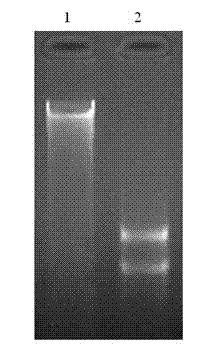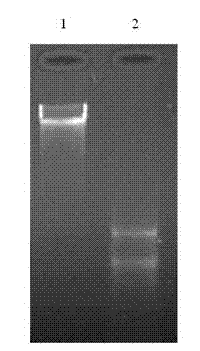Method for simultaneously extracting DNA (deoxyribonucleic acid) and RNA (ribonucleic acid) from lily tissue
A lily and tissue technology, applied in the field of plant molecular biology, can solve the problems of time-consuming, only for a single DNA or RNA, and low separation efficiency, and achieve the effect of short time-consuming and easy operation
- Summary
- Abstract
- Description
- Claims
- Application Information
AI Technical Summary
Problems solved by technology
Method used
Image
Examples
Embodiment 1
[0034] Embodiment 1: the method for extracting RNA and DNA simultaneously from Lily of the Minjiang River scale, concrete operation is as follows:
[0035] (1) Take 0.8g of young young scales of wild Minjiang lily quick-frozen in liquid nitrogen, grind them into powder with liquid nitrogen, transfer the sample powder to a centrifuge tube quickly, add 12mL of pre-cooled guanidine isothiocyanate extraction buffer, and shake fully Mix well and place on ice for 12min, then add 1.2mL 3mol L -1 Sodium acetate (pH5.0), mixed upside down; the composition of guanidine isothiocyanate extraction buffer: 4.5mol L -1 Guanidine isothiocyanate, 25mmol L -1 Sodium citrate, 0.5% (w / v) sodium lauryl sarcosine, 3% (w / v) soluble polyvinylpyrrolidone, 1 mL of β-mercaptoethanol per 100 mL of extraction buffer before use;
[0036] (2) Add 12 mL of chloroform to the sample mixture obtained in step (1), shake vigorously to mix, place on ice for 5 minutes, then centrifuge at 12000g at 4°C for 10 min...
Embodiment 2
[0048] Embodiment 2: the method for extracting RNA and DNA simultaneously from the leaf of Lilium siberia, concrete operation is as follows:
[0049] (1) Take 1 g of the young leaves of Oriental lily variety Siberia quick-frozen in liquid nitrogen, grind them into powder with liquid nitrogen, transfer the sample powder to a centrifuge tube quickly, add 12 mL of pre-cooled guanidine isothiocyanate extraction buffer, and shake fully Mix well and place on ice for 15min, then add 1.2mL 3mol L -1 Sodium acetate (pH4.5), mixed upside down; the composition of guanidine isothiocyanate extraction buffer: 4.5mol L -1 Guanidine isothiocyanate, 25mmol L -1 Sodium citrate, 0.5% (w / v) sodium lauryl sarcosine, 3% (w / v) soluble polyvinylpyrrolidone, 1 mL of β-mercaptoethanol per 100 mL of extraction buffer before use;
[0050] (2) Add 12 mL of chloroform to the sample mixture obtained in step (1), shake vigorously to mix, place on ice for 5 minutes, then centrifuge at 12000g at 4°C for 10 ...
Embodiment 3
[0062] Embodiment 3: from the method for simultaneously extracting RNA and DNA from Tongjiang lily root, concrete operations are as follows:
[0063] (1) Take 0.5g of the young Lily of Tongjiang root that was quick-frozen in liquid nitrogen, grind it into powder with liquid nitrogen, transfer the sample powder to a centrifuge tube quickly, add 6.5mL of pre-cooled guanidine isothiocyanate extract, and shake fully Mix well and place on ice for 10min, then add 0.65mL 3mol L -1 Sodium acetate (pH5.5), mixed upside down; the composition of guanidine isothiocyanate extraction buffer: 4.5mol L -1 Guanidine isothiocyanate, 25mmol L -1 Sodium citrate, 0.5% (w / v) sodium lauryl sarcosine, 3% (w / v) soluble polyvinylpyrrolidone, 1 mL of β-mercaptoethanol per 100 mL of extraction buffer before use;
[0064] (2) Add 6.5 mL of chloroform to the sample mixture obtained in step (1), shake vigorously and mix well, place on ice for 5 minutes, then centrifuge at 12000g at 4°C for 10 minutes...
PUM
 Login to View More
Login to View More Abstract
Description
Claims
Application Information
 Login to View More
Login to View More - R&D
- Intellectual Property
- Life Sciences
- Materials
- Tech Scout
- Unparalleled Data Quality
- Higher Quality Content
- 60% Fewer Hallucinations
Browse by: Latest US Patents, China's latest patents, Technical Efficacy Thesaurus, Application Domain, Technology Topic, Popular Technical Reports.
© 2025 PatSnap. All rights reserved.Legal|Privacy policy|Modern Slavery Act Transparency Statement|Sitemap|About US| Contact US: help@patsnap.com



